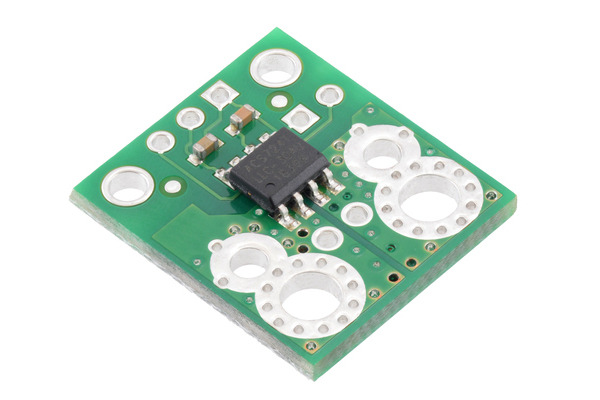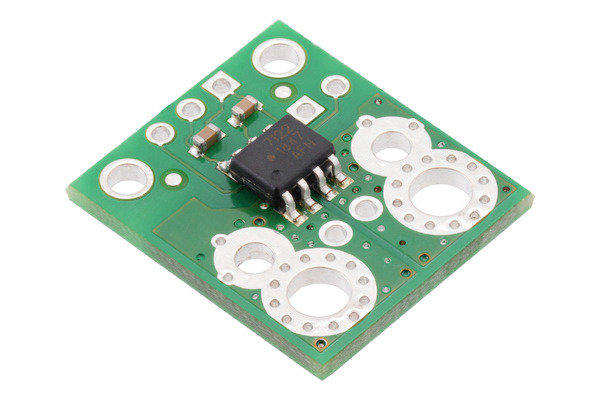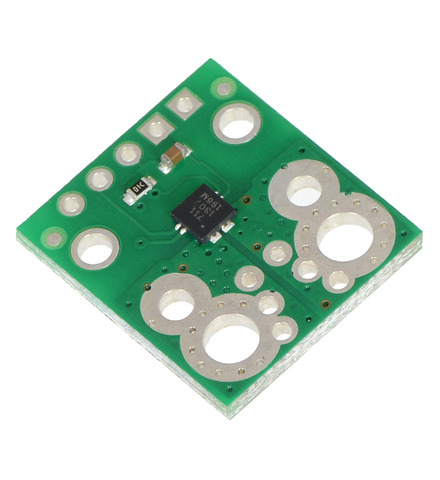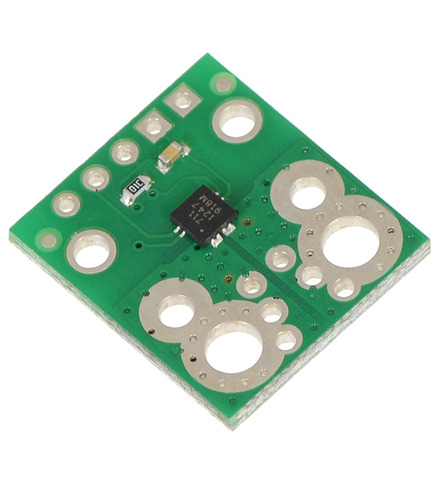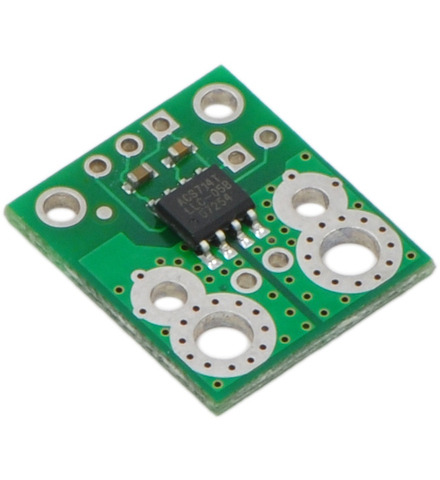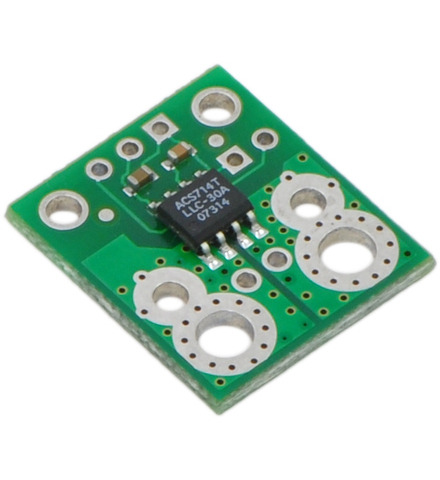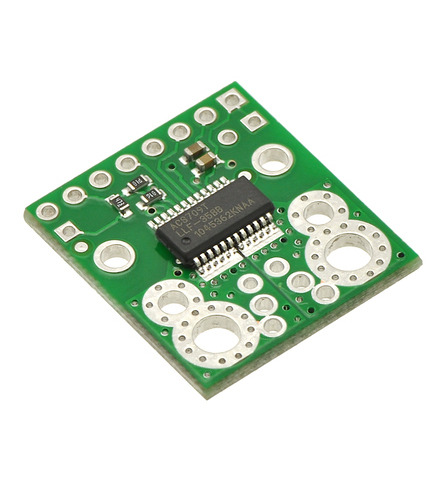Electronics » Sensors »
Current Sensors
Our bidirectional and unidirectional Hall effect current sensors are a simple way to gain fundamental insight into the performance of your system. You can use them for closed-loop torque control of actuators, tracking power consumption over time, load detection, over-current fault protection, or even as inexpensive current probes for an oscilloscope.
These current sensors output an analog voltage that varies linearly with the current passing through them, and because they use the Hall effect to measure the current, they offer full electrical isolation of the current path from the sensor’s electronics. This method of sensing means the sensor can be inserted anywhere into the current path, including on the high side, and because their current path resistance is on the order of 1 mΩ or less, they have minimal effect on the rest of the system.
All of our current sensor carrier boards (also called breakout boards) feature multiple options for making connections. For low-current applications, they all include at least one pair of through-holes compatible with 0.1″ male header pins, and for higher-current applications, the larger through-holes can be used for either soldering wires directly to the board or connecting solderless ring terminals.
The comparison table below summarizes our full selection of current sensors:
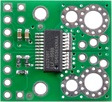 ACS709 Current Sensor Carrier |
 ACS711EX Current Sensor Carriers |
 ACS714 Current Sensor Carriers |
 ACS724 Current Sensor Carriers |
 ACHS-712x Current Sensor Carriers |
|||||||
|---|---|---|---|---|---|---|---|---|---|---|---|
| Sensor IC: | ACS709 | ACS711EX | ACS714 | ACS724 | ACHS-712x | ||||||
| Current range / sensitivity(1): | ±75 A / 28 mV/A | ±15.5 A / 136 mV/A ±31 A / 68 mV/A |
±5 A / 185 mV/A ±30 A / 66 mV/A |
0–10 A / 400 mv/A 0–30 A / 133 mV/A ±5 A / 400 mV/A ±20 A / 100 mV/A ±50 A / 40 mV/A |
±10 A / 185 mV/A ±20 A / 100 mV/A ±30 A / 66 mV/A ±40 A / 50 mV/A ±50 A / 40 mV/A |
||||||
| Path resistance: | 1.1 mΩ | 0.6 mΩ | 1.2 mΩ | 1.2 mΩ | 0.7 mΩ | ||||||
| Bandwidth | 120 kHz | 100 kHz | 80 kHz | 120 kHz | 80 kHz | ||||||
| Vcc range:(1) | 3 V–5.5 V | 3 V–5.5 V | 4.5 V–5.5 V | 4.5 V–5.5 V | 4.5 V–5.5 V | ||||||
| Size: | 0.82″ × 0.9″ | 0.7″ × 0.8″ | 0.7″ × 0.8″ | 0.7″ × 0.8″ | 0.7″ × 0.8″ | ||||||
| Special features: | configurable over-current threshold, low-voltage operation, high bandwidth |
over-current fault pin, low-voltage operation |
Differential Hall sensing rejects common-mode fields, high bandwidth |
||||||||
| 1-piece price: | $14.95 | $3.95 | $19.95 | $14.95 | $6.95 | ||||||
| 1 Sensitivity based on when Vcc is 5V. | |||||||||||
 Compare all products in this category
Compare all products in this category
Subcategories
These boards are simple carriers of Allegro’s ACS724 Hall effect-based linear current sensors, which offer a low-resistance (~1.2 mΩ) current path and electrical isolation up to 2.4 kV RMS. They operate from 4.5 V to 5.5 V and output an analog voltage proportional to the current.
These boards are simple carriers of Broadcom’s ACHS-712x Hall effect-based linear current sensors, which offer a low-resistance (~0.7 mΩ) current path and electrical isolation up to 3 kV RMS. They operate from 4.5 V to 5.5 V and output an analog voltage proportional to the current.
Products in category “Current Sensors”
| Pololu item #: 2452 | |
| Brand: Pololu | |
| Status: Active and Preferred | |

|
|
This board is a simple carrier of Allegro’s ±15.5 A ACS711 Hall effect-based linear current sensor with overcurrent fault output, which offers a low-resistance (~0.6 mΩ) current path and electrical isolation up to 100 V. This version accepts a bidirectional current input with a magnitude up to 15.5 A and outputs a proportional analog voltage centered at Vcc/2 with a typical error of ±5%. It operates from 3 V to 5.5 V, so it can interface directly to both 3.3 V and 5 V systems.
| Pololu item #: 2453 | |
| Brand: Pololu | |
| Status: Active and Preferred | |

|
|
This board is a simple carrier of Allegro’s ±31 A ACS711 Hall effect-based linear current sensor with overcurrent fault output, which offers a low-resistance (~0.6 mΩ) current path and electrical isolation up to 100 V. This version accepts a bidirectional current input with a magnitude up to 31 A and outputs a proportional analog voltage centered at Vcc/2 with a typical error of ±4%. It operates from 3 V to 5.5 V, so it can interface directly to both 3.3 V and 5 V systems.
| Pololu item #: 1185 | |
| Brand: Pololu | supply outlook |
| Status: End-of-Life Rationing | |

|
|
This board is a simple carrier of Allegro’s ±5A ACS714 Hall effect-based linear current sensor, which offers a low-resistance (~1.2 mΩ) current path and electrical isolation up to 2.1 kV RMS. This version accepts a bidirectional current input with a magnitude up to 5 A and outputs a proportional analog voltage (185 mV/A) centered at 2.5 V with a typical error of ±1.5%. It operates from 4.5 V to 5.5 V and is intended for use in 5 V systems.
| Pololu item #: 1187 | |
| Brand: Pololu | |
| Status: Obsolete | |

|
|
Please consider the ACHS-7123 Current Sensor Carrier -30A to +30A as an alternative that can serve as a drop-in replacement in typical applications.
This board is a simple carrier of Allegro’s ±30A ACS714 Hall effect-based linear current sensor, which offers a low-resistance (~1.2 mΩ) current path and electrical isolation up to 2.1 kV RMS. This version accepts a bidirectional current input with a magnitude up to 30 A and outputs a proportional analog voltage (66 mV/A) centered at 2.5 V with a typical error of ±1.5%. It operates from 4.5 V to 5.5 V and is intended for use in 5 V systems.
| Pololu item #: 2199 | |
| Brand: Pololu | |
| Status: Rationed (Active) | |

|
|
This board is a simple carrier of Allegro’s ±75A ACS709 Hall effect-based linear current sensor with overcurrent fault output, which offers a low-resistance (~1.1 mΩ) current path and electrical isolation up to 2.1 kV RMS. The sensor has optimized accuracy for currents from -37.5 A to 37.5 A, and the analog voltage output is linear for current magnitudes up to 75 A. The ratiometric output voltage is centered at VCC/2 and has a typical error of ±2%. It operates from 3 V to 5.5 V, so it can interface directly to both 3.3 V and 5 V systems.
